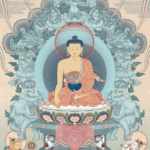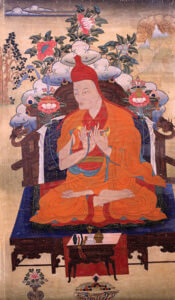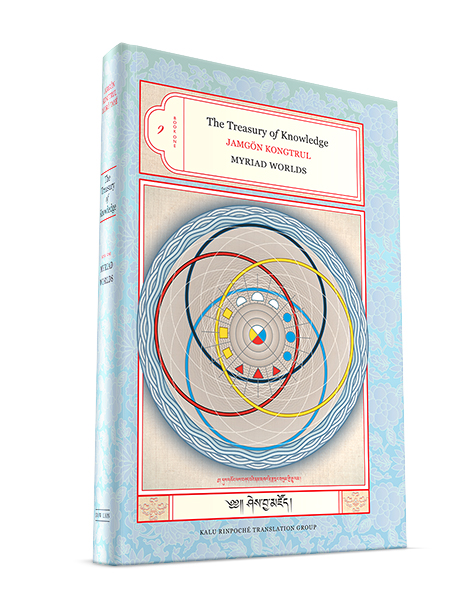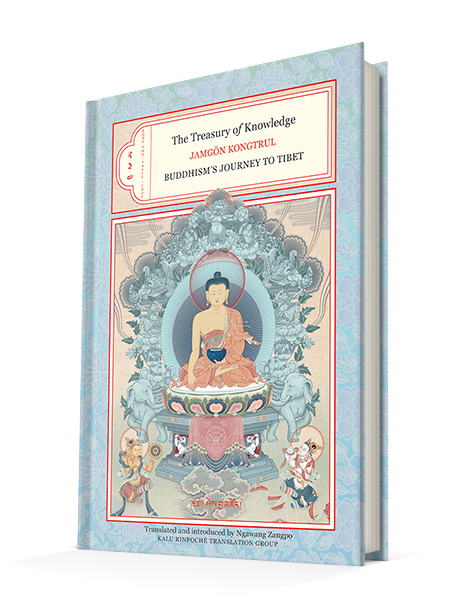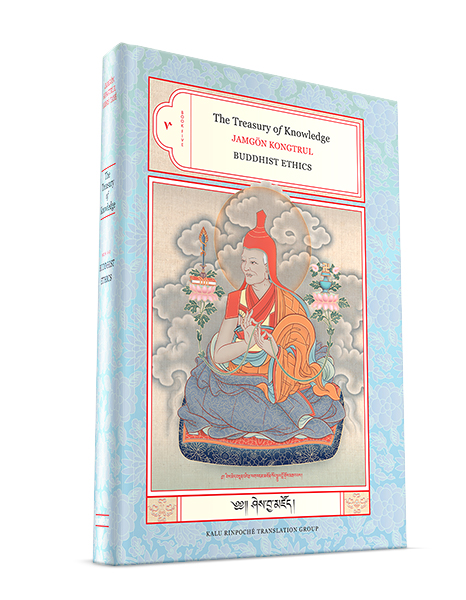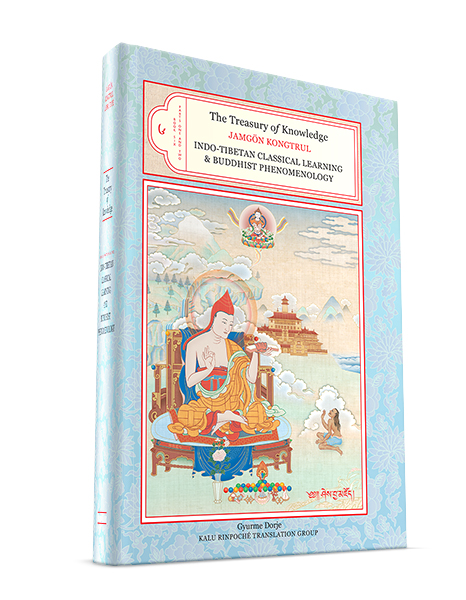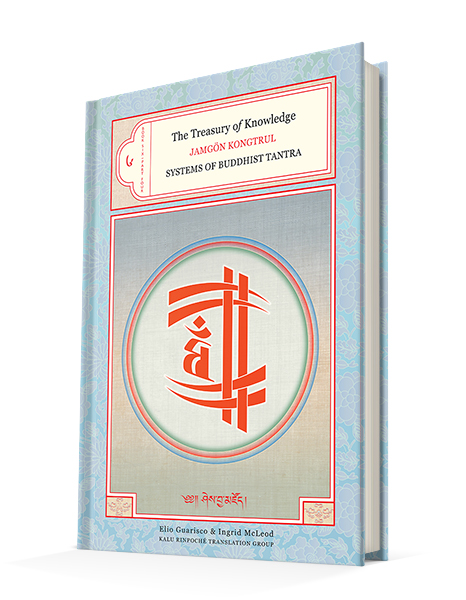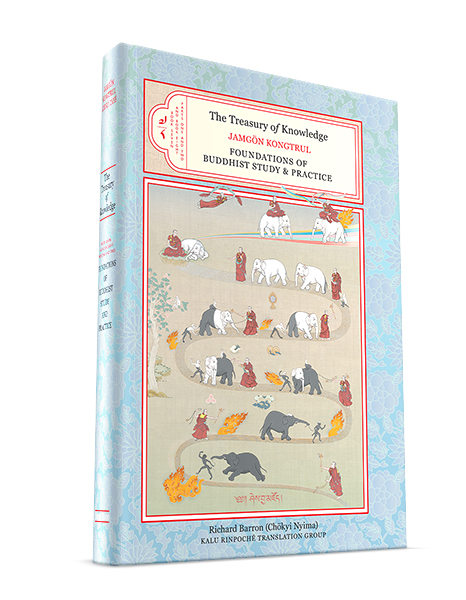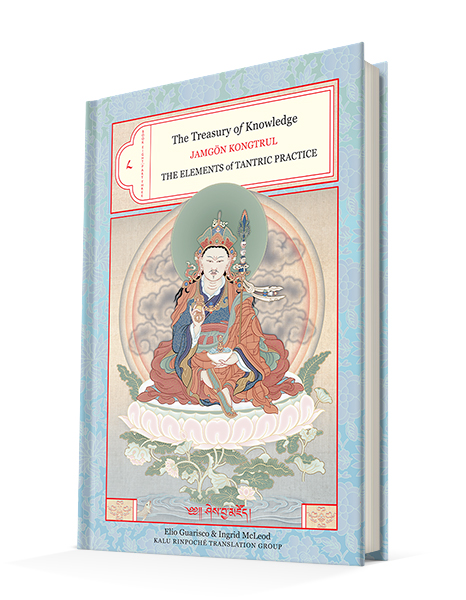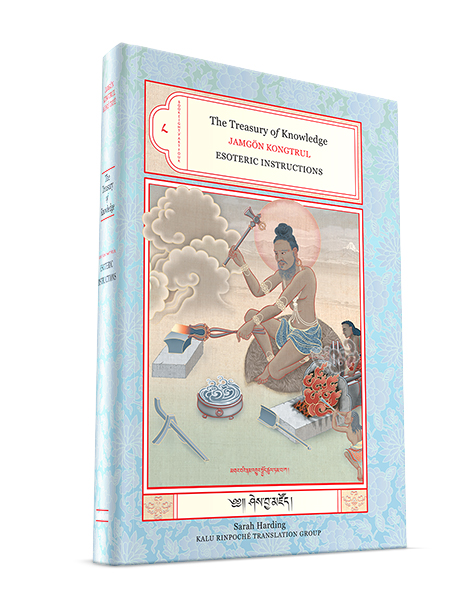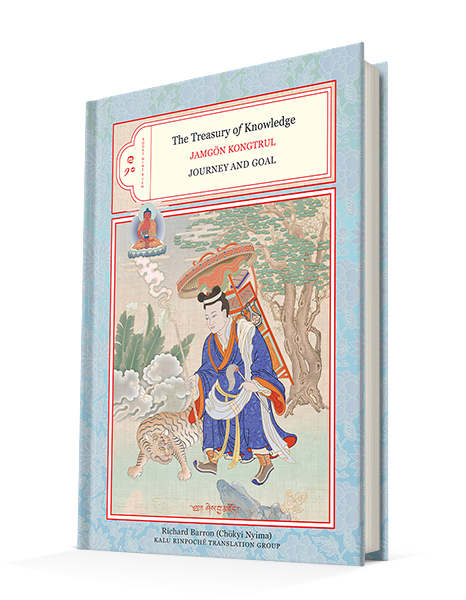About the Treasury of Knowledge, the Sheja Kun La Khyabpé Dzö
The ten volumes that make up the Treasury of Knowledge were first published in Tibetan in 1875. Jamgon Kongtrul had been asked to write something on the three levels of Buddhist vows but instead the project expanded way beyond that scope. Kongtrul said that he wanted to produce something that "should be more comprehensive in scope, something that would be of use to people who had not studied much.” In practice he used the work as a prerequisite for those entering into the three year retreat to have a basis of study before the intensive practice retreat.
In 1986 Kyabje Kalu Rinpoche began floating the idea of translating the Treasury into English. While it took over over twenty-five years to complete, his vision was fulfilled and we can all be grateful for access to this extraordinary work.
Over the ten volumes, the entire Buddhist path is presented from a tantric point of view.

The project was begun by Kalu Rinpoche and his International Translation Group under the direction of Khenpo Lodro Donyo Rinpoche in 1987 with a three month workshop held in Bodhgaya including 40 translators from around the world. In 1988 a second workshop in Bodhgaya of 18 translators continued this work. It became evident that this was a long term project and a core group of translators - Ingrid McLeod, Elio Guarisco, Ngawang Zangpo, Anthony Chapman, Olivier and Lydia Brunet settled in Kalu Rinpoche’s monastery in Sonada, India and for the next six years continued working on the translation project assisted by occasional visits of passing translators and editors. The result of this effort was the first two volumes of the series to be published: Myriad Worlds and Buddhist Ethics. Others contributing or assisting in these first two volumes included many familiar names: Sarah Harding, Yeshe Wangmo, Peter Roberts, Jim and Birgitte Scott, Eric Pema Kunzang, Ken McLeod, Dechen Eva Cronin, Matthieu Ricard, Norbu Tsewang, Dan Perdue, William Waldron, Surya Das, Samten Zangmo and many others.
Subsequently the project was taken on by Tsadra Foundation who sought out additional translators and completed the project in 2012. At this stage, the following individual translators were allocated responsibility for specific volumes: Sarah Harding, Richard Barron, Ngawang Zangpo, Elio Guarisco, Ingrid McLeod, Gyurme Dorje, Elizabeth Callahan.
Books in the Series
The forty chapters that make up the Treasury in Tibetan are contained in the ten volumes of the English edition.
To order multiple volumes at once, visit our series order page.
Myriad Worlds
Book One
This first book of The Treasury which serves as a prelude to Kongtrul's survey describes four major cosmological systems found in the Tibetan tradition—those associated with the Hinayana, Mahayana, Kalachakra, and Dzogchen teachings. Each of these cosmologies shows how the world arises from mind, whether through the accumulated results of past actions or from the constant striving of awareness to know itself.
Buddhism's Journey To Tibet
Books Two, Three, and Four
Buddhism’s Journey to Tibet presents Kongtrül's masterful history of Buddhism in India and Tibet. Beginning with the appearance of the Buddha in our world (Book Two), it describes the Buddha's life, his enlightenment, and what he taught (Book Three) from a multitude of Buddhist viewpoints. Buddhism's transmission to and preservation in Tibet is the focus of the main part of this volume (Book Four), which describes the scriptural transmissions and lineages of meditation practice as well as the Buddhist arts that together make up the world of Tibetan Buddhism.
Buddhist Ethics
Book Five
This volume is the fifth book of that work and is considered by many scholars to be its heart. Jamgön Kongtrül explains the complete code of personal liberation as it applies to both monastic and lay persons, the precepts for those aspiring to the life of a bodhisattva, and the exceptional pledges for practitioners on the tantric path of pure perception.
Indo-Tibetan Classical Learning and Buddhist Phenomenology
Book Six, Parts One and Two
The first two parts of Book Six, contained in this volume, respectively concern Indo-Tibetan classical learning and Buddhist phenomenology. The former analyzes the traditional subjects of phonology and Sanskrit grammar, logic, fine art, and medicine, along with astrology, poetics, prosody, synonymics, and dramaturgy. The principal non-Buddhist philosophical systems of ancient India are then summarized and contrasted with the hierarchical meditative concentrations and formless absorptions through which the “summit of cyclic existence” can genuinely be attained. Part Two examines the phenomenological structures of Abhidharma—the shared inheritance of all Buddhist traditions—from three distinct perspectives, corresponding to the three successive turnings of the doctrinal wheel.
Frameworks of Buddhist Philosophy
Book Six, Part Three
This volume is the fifth book of that work and is considered by many scholars to be its heart. Jamgön Kongtrül explains the complete code of personal liberation as it applies to both monastic and lay persons, the precepts for those aspiring to the life of a bodhisattva, and the exceptional pledges for practitioners on the tantric path of pure perception.
Systems of Buddhist Tantra
Book Six, Part Four
The tantric path is often referred to as the indestructible way of secret mantra, the essence of which is the indestructible union of wisdom (the understanding of emptiness) and method (immutable great bliss). This volume sets forth the various systems that constitute this path, both those of the ancient tantra tradition and of the new tradition.
Foundations of Buddhist Study and Practice
Book Seven and Book Eight, Parts One and Two
Foundations of Buddhist Study and Practice comprises Book Seven and Book Eight, Parts One and Two of the Treasury of Knowledge. Book Seven elucidates the various keys needed to correctly interpret, understand, and contemplate Buddhist teachings, including the secret teachings of the Vajrayana. Parts One and Two of Book Eight explain how the teachings are to be integrated into one’s life through the practice of meditation, which unites a state of one-pointed attention with profound insight into emptiness. Jamgön Kongtrul’s evenhanded, elegant, and authoritative statement of such controversial doctrines as unqualified emptiness (“self-empty”) and qualified emptiness (“other-empty”), provisional and definitive meaning, and conventional and ultimate truth as presented in the various schools of Tibetan Buddhism will appeal to both serious Dharma practitioners and advanced students and scholars.
The Elements of Tantric Practice
Book Eight, Part Three
The Elements of Tantric Practice sets forth the essential components of the path of highest yoga tantra, a system of meditation that unites wisdom and compassion in its two phases of practice. The first phase, that of creation, relies primarily on the use of the imagination to effect personal transformation. The phase of completion allows the practitioner to perfect the process of transformation by training in methods that manipulate the energies and constituents of the mind and body. The result of this path is the direct experience of the fundamental nature of mind and phenomena. The Elements of Tantric Practice concerns the meditative processes of the inner system of secret mantra—that of highest yoga tantra—and is based primarily on tantric sources.
The author introduces the subject by describing the path of tantra and its underlying principles. The main body of the book deals with two major elements essential to all highest yoga tantras: the practice of the creation phase and that of the completion phase. For the first phase, Kongtrül describes the visualization sequences in which ordinary perceptions are transformed into the forms of awakening and explains how these practices purify the stages of cyclic existence—life, death, and rebirth. The creation phase prepares the practitioner for the techniques of the completion phase, which entail focusing directly on the channels, winds, and vital essences that form the subtle body. Kongtrül presents the key elements of a variety of tantras, including the Guhyasamaja and Yamari, belonging to the class of father tantras and the Kalachakra Hevajra Chakrasamvara Mahamaya Buddhakapala and Tara mother tantras. All these tantras share a common goal: to make manifest the pristine awareness that is the union of emptiness and bliss.
Esoteric Instructions
Book Eight, Part Four
Esoteric Instructions, deals with meditation—specifically tantric meditation. Esoteric Instructions is a collection of intimate records of personal teachings by masters that simplify tantric meditations by providing pertinent examples and very personal and helpful hints to disciples based on the master's own experience. Although originally oral in nature, they have been codified and passed down through specific lineages from teacher to student.
Journey and Goal
Books Nine and Ten
Journey and Goal focuses on the spiritual path—the journey and the resultant state of enlightenment to which it leads—the goal. Extensively varied perspectives are offered not only from within the many schools of Buddhism but also from the different levels of practice and attainment. This is in fact the most comprehensive treatment of these themes to appear in the English language.

